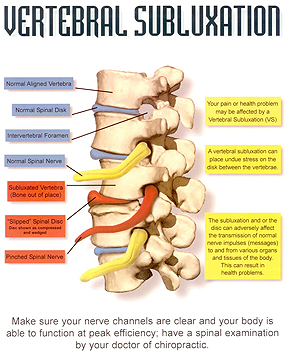Subluxation

Subluxation is a term used in the chiropractic field to describe what happens when one of the vertebrae in your spine moves out of position. The word “subluxation” is derived from the Latin words meaning somewhat or slightly (sub) and to dislocate (luxate). When this happens, the misaligned vertebra creates pressure and stress on the spinal nerves, blood vessels, and surrounding muscles. This pressure and stress can cause an imbalance in the body’s normal processes as the nerves in the spinal column extend to the entire body and its organs. As time goes on and the uncorrected subluxation settles, the damage to the nerve gets progressively worse different stages of subluxation degeneration set in. Regular visits to a licensed chiropractor can help to reduce the effects of subluxation and may be necessary maintain good health and physical fitness.
What causes subluxation?
There are two types of ways that a subluxation can occur: unique instances or regular actions. A car accident, fall, sudden jar, or trauma are all examples of unique instances that may cause a subluxation. The other occurrence of subluxation comes from regular actions such as improper sleeping position, poor posture, or incorrect lifting processes
How is subluxation corrected?
Chiropractors are specialists in correcting subluxation and other misalignments. A chiropractor can restore the misaligned vertebrae to their proper position in the spinal column. They do this manually by using the chiropractic procedure known as spinal adjustment. Your chiropractor, in most cases, will use his or her hands in applying corrective pressure to the spine in a specific direction and location. The manual force or thrust helps restore the alignment and mobility of the vertebrae. In some cases, the chiropractor may use instruments to detect a subluxation and adjust the spine. Under normal circumstances, chiropractic adjustments are painless. In cases of trauma, such as car accident, some discomfort may be experienced due to inflammation. It is also common to feel a brief sensation in the extremities immediately following an adjustment due to the sudden decompression of the affected nerve root.
DIFFERENT PHASES OF SUBLUXATION DEGENERATION
Phase One Subluxation Degeneration
Phase one subluxation degeneration is seen in subluxations that have been present for up to twenty years. This phase is characterized with a loss or change in the normal curve in the spine. In this phase, the normal forward curve is in the neck can be lost. The spine can even develop a reverse curve in the neck. Although overall motion is probably not affected, chiropractic reconstructive care for a phase one subluxation can take from 6 to 18 months. More than 80% of people with phase one subluxation degeneration have no pain. Therefore, if left uncorrected, phase one continues to progress with time until it eventually reaches the next phase.
Phase Two Subluxation Degeneration
Phase two subluxation degeneration is normally seen in subluxations that have been present between 20 and 40 years. This phase has some of the same characteristics of the previous phase including a loss of normal curvature and position as well as an alteration in small motions. In addition, spines with phase two subluxation degeneration often show a reduction in the patient’s range of motion in that area. X-rays of a phase two begin to show calcium changes or buildup at certain levels of the spine. These changes are sometimes called by many names including spurs and arthritis. Disc spaces between the affected vertebrae are noticeably narrower and may appear to be flattening out. Although most people with phase two subluxation degeneration may not exhibit any symptoms, some may start to feel stiff or achy. Chiropractic reconstructive care for patients in phase two ranges from 1.5 years to 2.5 years. Again, if phase two subluxation degeneration is left uncorrected it slowly advances to the next phase.
Phase Three Subluxation Degeneration
Phase three subluxation degeneration is caused by subluxations that have gone untreated for between 40 and 65 years. This phase has all of the attributes of the previous phases, only worse. The curvatures are abnormal, the disc spaces are vastly decreased and changed. Calcium changes on the spine are abundant in this phase. Normally, people in phase three have a restricted range of motion and probably exhibit symptoms of some kind. In phase three the vertebrae show obvious changes and mutations in shape. Chiropractic reconstructive care for patients in phase three ranges from 2.5 years to 3.5 years. This does not mean that at the end of this time that any or all of the calcium changes will be gone. In many instances the body adapts to the presence of the calcium and positive changes can only be measured from a functional standpoint. As before, if phase three subluxation degeneration is left unchecked it slowly advances into the final phase.
Phase Four Subluxation Degeneration
Phase four subluxation degeneration is seen with subluxations that have been raging on uncorrected or altered for over sixty five years. Phase four is a grave condition that will negatively affect the patients longevity and quality of life. The massive amount of neurological damage caused by years of subluxation that have lead to phase four are probably taking a serious toll on this person’s health status. X-rays in phase four show serious severe structural changes. Vertebrae exhibit massive calcium changes, disc spaces appear blurred, and the bones themselves appear fused. In this scenario the patient will have a severe restriction of range of motion in addition to probably a number of other health issues. Reconstruction may not be possible in phase four, but care can be directed to some reduction in subluxation with the goal of improvement in the quality of life remaining. Patients in phase four subluxation degeneration have a serious situation both structurally and neurologically, but they are certainly not beyond hope. Many chiropractic patients in phase four report significant improvements in symptoms, conditions, mobility and quality of life.